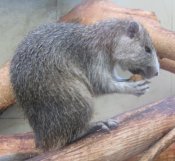 The Desmarest's Hutia (Capromys pilorides) lives in Cuba and on adjacent islands, but they are not confined to a single habitat. They could be seen all over Cuba, namely: cloud forests, forests, arid semi-deserts, marshy parts and the mountains. Desmarest's Hutias could be segregated in 2 classes, those residing in North Cuba, and those at South Cuba's territory. Hutias living at the north side are in the marshes, places characterized by a lot of red mangroves. The Desmarest's Hutia of this kind stays in the parts of those mangroves. On the other side, those living at the south exhibit a much more terrestrial trait.
The Desmarest's Hutia (Capromys pilorides) lives in Cuba and on adjacent islands, but they are not confined to a single habitat. They could be seen all over Cuba, namely: cloud forests, forests, arid semi-deserts, marshy parts and the mountains. Desmarest's Hutias could be segregated in 2 classes, those residing in North Cuba, and those at South Cuba's territory. Hutias living at the north side are in the marshes, places characterized by a lot of red mangroves. The Desmarest's Hutia of this kind stays in the parts of those mangroves. On the other side, those living at the south exhibit a much more terrestrial trait.A Desmarest's Hutia could weigh from 1 all the way to 9 kgs, but the average could be placed at seven kilograms. These Hutias are considered of the biggest kind, but their movements are anything but graceful. Having short legs, they move in unsteady fashion, "waddling" would be the best word. Still, if a Desmarest's Hutia's life is on the line, (say, a predator aims to turn him into breakfast), the waddling becomes hopping...
They have rough fur and the dorsal part is usually with a darker hue. Shades of the covering vary: black, brown, yellowish and even red. Its tail is totally hidden from view, with all the hair, and their claws are big.
These hutias possess a very elaborate stomach structure. It is divided into 3 segments, making it the most complicated stomach morphology as far as rodents are concerned.
Picture of the Desmarests Hutia licensed under GFDL
The Desmarest's hutia is listed as Least Concern (LR/lc), lowest risk. Does not qualify for a more at risk category. Widespread and abundant taxa are included in this category, on the IUCN Red List of Threatened Species
Some facts about the
Cuban hutia
Adult weight : 4.683 kg (10.3026 lbs)
Maximum longevity : 14 years
Female maturity :304 days
Male maturity : 304 days
Gestation : 125 days
Weaning : 100 days
Litter size : 2
Weight at birth : 0.24 kg (0.528 lbs)
Basal metabolic rate : 3 W
Body mass : 2.63 kg (5.786 lbs)
Temperature : 35.85 °C (96.53 °F)

Custom Search